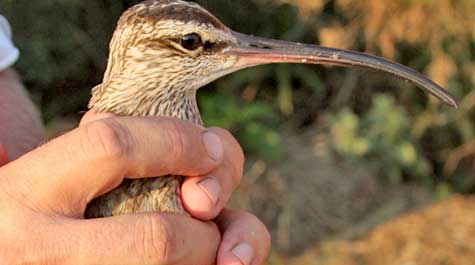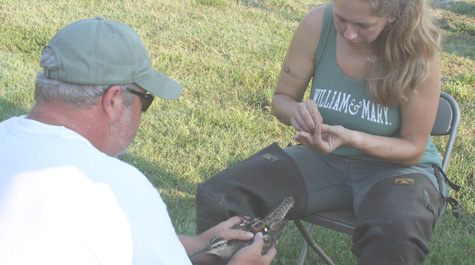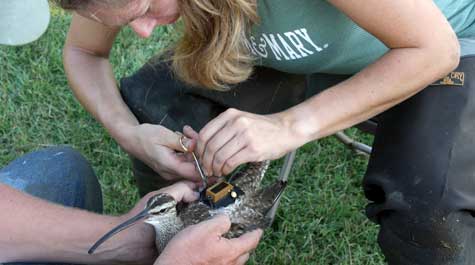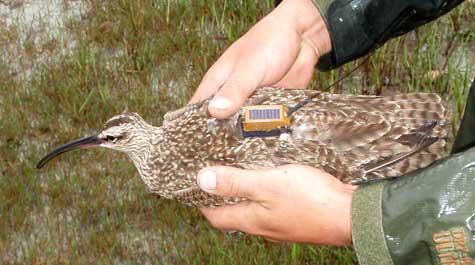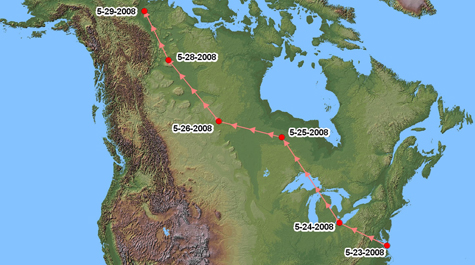Winnie the whimbrel: RIP
The fast-flying, wire-wearing, record-breaking shorebird known as Winnie the whimbrel is missing and presumed dead near the Wisconsin shore of Lake Superior on her way south and east from her Alaskan breeding grounds.
Bryan Watts, director of William and Mary's Center for Conservation Biology, said Winnie was likely on her way back to the east coast—possibly to the Eastern Shore—when she ran into sustained strong headwinds that probably left her weak and in an inhospitable place.
"We feel this bird ran out of gas, and didn't have a place to refuel," Watts said. "The area where she went down is remote and the ground cover is really thick, so it's not likely that the tracking unit or bird will be recovered." He said a group from The Nature Conservancy checked out the area, as did some local bird researchers mobilized by the CCB's Fletcher Smith, a native of the area.
Winnie made news after her record-breaking migratory flight last spring from the Delmarva Peninsula to the McKenzie River basin on the Alaska-Canada border. The bird was fitted with a state-of-the-art satellite tracking device weighing just over a third of an ounce by researchers from the Center for Conservation Biology and The Nature Conservancy.
Winnie left the study area on May 23. The scientists expected Winnie to head for known whimbrel breeding grounds south and west of Hudson's Bay. Instead, Winnie took off northwest, flying more than 5,000 kilometers (3,200 miles) in no more than 146 hours. The flight—probably nonstop—was a distance record for the species and Winnie logged an average flight speed of nearly 22 miles per hour.
After Winnie made her record-setting trip to the McKenzie River, she continued to her breeding grounds in Alaska's Colville River system above the Arctic Circle. She remained on the breeding grounds from June 7 to July 12, when she began moving west. Her transmitter was still working, allowing CCB researchers to track her movements along Alaska's western edge.
Trouble-filled return trip
The bird ran into trouble as soon as she left Alaska on Aug. 3.
"She went down to a drainage that's a well-known staging area in the west coast of Alaska and staged for a long period of time," Watts said, then she took off south over the north Pacific and straight into the teeth of a cyclone. "We thought there was a chance the bird could be lost then. But it then went east to Washington, to Willapa Bay."
By coincidence, Watts happened to be at a conference in Oregon and he went up to Willapa Bay to look for Winnie, who was feeding up in what he called "a beautiful shorebird staging area" after fighting 50 mile per hour cyclone winds during her 1,000-mile flight from Alaska.
Watts couldn't find the bird, who stayed in Willapa Bay, resting and refueling from Aug. 7 to Aug. 23. He expected her to fly down the Pacific Coast, perhaps to wintering grounds in Central America, but Winnie surprised trackers by heading east again, on what would be the last of her great migratory flights.
"That bird turned inland and made another flight," Watts said, " another 1,000 mile flight. And then finally made it to Lake Superior there in Wisconsin." Winnie encountered stiff headwinds over the high plains, ending up in a poor foraging area and "just ran out of gas," Watts said.
"How frequently this sort of thing happens, we have no idea. We have evidence of major die-offs over the Atlantic where some birds go out and the storm comes and lots of carcasses wash up. We've actually lost a peregrine down over the Atlantic before," he explained. "It kind of highlights the significance of these places like the Delmarva, which have incredibly high food resources. That's why they're attracted to these areas. But to be lost in a place where you don't have much to feed on, that's a risk that the birds take."
Whimbrel studies will continue
The CCB is continuing its study of whimbrel migration. "We have plans to put several more transmitters out next spring and fall and so once you start putting out numbers of these, you get a better sense of what the normal patterns are," he said.
Watts said they fitted another whimbrel with a transmitter three weeks ago, only to see it head for South America, flying into the Hanna-Ike-Josephine "conga line" of storms.
"There's nowhere to hide out there in the middle of the ocean," Watts said. " That bird made landfall in one of the islands of the Bahamas, a single flight. I'm hoping it stays there until that area clears."
The Center for Conservation Biology maintains a whimbrel page, which includes a map of Winnie's record-breaking westbound flight.
 Skip to main content
Skip to main content

